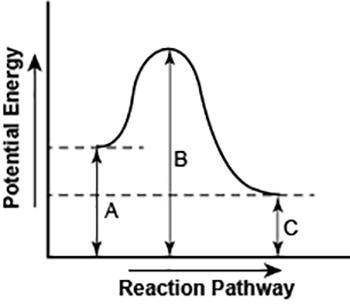
Chemistry, 21.04.2021 07:10, minelly1717
Part 1: Looking at the diagram above, what can you tell me about the type of reaction it is? Is this exothermic or endothermic? How do you know? Make sure you support your answer by using the diagram.
Part 2: Thinking about enthalpy and a change in enthalpy, explain how you could find the total change of enthalpy based on this diagram. Is the enthalpy positive or negative?
Part 3: How could you find the activation energy? Is the activation energy positive or negative?


Answers: 2
Other questions on the subject: Chemistry

Chemistry, 20.06.2019 18:02, joclowdus99
Which is an example of renewableenergy resource uranium ,wind, or natural gas
Answers: 2

Chemistry, 22.06.2019 18:00, ameliaxbowen7
Heat is the total potential energy of a substance that can be transferred. true false
Answers: 1

Chemistry, 22.06.2019 22:00, notearslefttocry14
Imagine one batch of soup (batch “a”) is made with 8.19 g/can of salt, according to the recipe, and a second batch of soup (batch “b”) is made with 8.32 g/can of salt. explain which batch would be more resistant to frost damage if it is shipped a great distance in winter and explain why.
Answers: 2

Chemistry, 23.06.2019 05:00, contrerasdaisy100
Activity two: just lemons, inc. production here's a one-batch sample of just lemons lemonade production. determine the percent yield and amount of leftover ingredients for lemonade production and place your answers in the data chart. hint: complete stoichiometry calculations for each ingredient to determine the theoretical yield. complete a limiting reactant-to-excess reactant calculation for both excess ingredients. water sugar lemon juice lemonade percent yield leftover ingredients 946.36 g 196.86 g 193.37 g 2050.25 g 89% just lemons lemonade recipe equation: 2 water + sugar + lemon juice = 4 lemonade mole conversion factors: 1 mole of water = 1 cup = 236.59 g 1 mole of sugar = 1 cup = 225 g 1 mole of lemon juice = 1 cup = 257.83 g 1 mole of lemonade = 1 cup = 719.42 g show your calculations below. analysis questions 1. based on taste observations only, which ingredients were in excess in the lemonade samples in activity one? in activity one the excess substances for each sample were the water and sugar. 2. based on the data in activity two, which excess ingredients are affecting the taste of the lemonade in the sample batch? 3. what can just lemons, inc. do during production to reduce the amount of excess ingredients and improve the taste of their lemonade? 4. try to reduce the amount of leftover ingredients by changing the amount of one, two, or all three starting ingredients. show your stoichiometric calculations below. 5. during factory inspection, just lemons, inc. discovered that a water valve to the lemonade mixing station was not functioning. once they repair it, more water will enter the mixing station. from what you know about the limiting and excess ingredients for current lemonade production, what advice would you give engineers about the upcoming increase in water?
Answers: 3
Do you know the correct answer?
Part 1: Looking at the diagram above, what can you tell me about the type of reaction it is? Is this...
Questions in other subjects:

Social Studies, 05.03.2021 22:30




Mathematics, 05.03.2021 22:40




Mathematics, 05.03.2021 22:40






